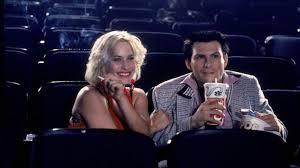

THE COURSE OF TRUE LOVE NEVER DID RUN SMOOTH: “Okie, dokey, doggie daddy.” We’ve all been there, done that. We meet someone. Fall in love. Pledge our lives to each other. Then, as so often happens, we kill someone or rob someone of drugs or money and have to go on the run. Who hasn’t found themselves in that situation? Sounds like it’s time for Episode 45 of Pop Art, the podcast where my guest chooses a movie from popular culture and I’ll select a film from the more art/classic side of cinema with a connection to it. This time, I am happy to welcome fellow podcaster Jarrett Galante, aka Clark F. Gable, who has chosen the Tony Scott/Quentin Tarantino neo-noir, True Romance, and I have chosen the quite different Jean Luc Godard French film classic, Pierrot le Fou, both about lovers on the run.
And in this episode, we answer such questions as: What did Tarantino do to raise money to make Reservoir Dogs and how does Elvis fit in? Are Tarantino and Godard post-modern or post-post-modern? How does the movie Pineapple Express fit in? Who is Sam Fuller and would you want to be one? Where did the Sicilian story come from in True Romance? Where does Godard stand in the pantheon of directors? Where does Tarantino? What are the differences between the original screenplay and the final one in True Romance and what did Tarantino think about it? Where did the True Romance theme come from?
Meanwhile check out Jarrett’s podcast The REAL Short Box at https://www.facebook.com/therealshortbox/
And Jarrett’s IDMB profile at https://www.imdb.com/name/nm1445425/?ref_=nv_sr_srsg_0 Continue reading

